商务英语视听说第一单元教案2
- 格式:doc
- 大小:69.50 KB
- 文档页数:4
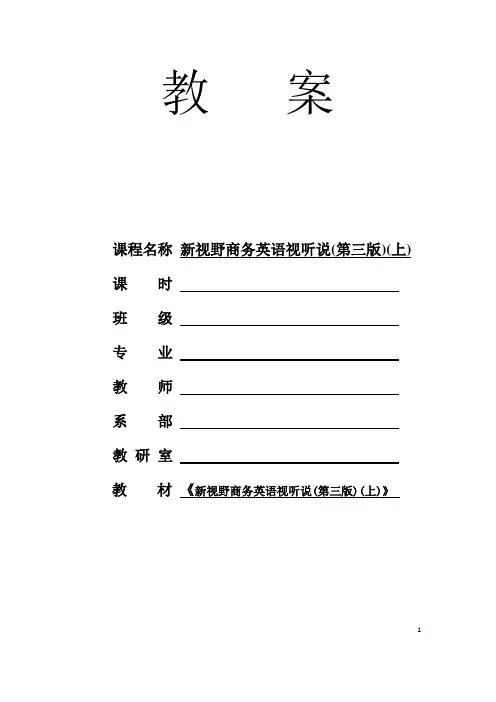
教案课程名称新视野商务英语视听说(第三版)(上) 课时班级专业教师系部教研室教材《新视野商务英语视听说(第三版)(上)》1Unit 2 Jobs and ResponsibilitiesLearning Objectives(教学目标)2Business Profile(内容概览)Want to Know About Jobs and Responsibilities in aCompany?OverviewThis unit mainly looks at various job titles and responsibilities in a company as people may be expected to talk about these aspects of their work. Firstly, an employee may have to show a visitor around the offices of their company. More generally, an employee may be asked to describe how the business is organised or structured. Furthermore, people in business may often be called upon to describe to outsiders or friends what their company actually does.A company is usually divided into departments covering areas such as administration, sales, billing, production, shipping, etc. Below is a chart showing some common departments and positions in the business world.Common Departments and Positions in a Company3Main Responsibilities of Some Common PositionsThese can vary a lot in different companies so the following is only a rough indication of the typical responsibilities.Senior Sales Manager●Work with a team of sales people and support staff to secure both new and old business and to deepen existing business relationships;●Monitor, encourage, advise and direct sales activity by individual sales staff in order to achieve revenue targets;●Define and plan the different steps of a project, allocate action and responsibilities within the overall project framework to achieve timely and cost-effective project completion.Financial Controller●Responsible for all accounting, financial and taxation matters;●Help local offices with budgeting and annual spending projections;●Arrange for internal and external audits, ensure checks and balances on spending;●Control and safeguard company assets, develop the matrix of levels of authority for expense review and approval.Human Resources Manager●Support the Business Head in setting strategy, direction and objectives with regard to personnel;●Responsible for hiring appropriate personnel and ensuring career progression;●Identify, interpret and apply key performance indicators and monitor business managers’use of such indicators;4●Review and evaluate proposals for job regrading, training, promotion, transfer, and salary progression with respect to business needs and internal relativity.Logistics Manager●Manage supplies, components, raw materials and inventories with the objective of ensuring production being constantly supported and stocked;●Manage imports, including customs clearance;●Negotiate and maintain contracts with transportation and freight companies. Account Manager●Support named customers, provide quotations, product recommendations and after sales advice;●Support the local sales staff with technical recommendations and communication with producers;●Develop new customers and other sales opportunities;●Act as an interface between factories and customers.Purchaser/Buyer●Responsible for supplier identification and pre-screening of materials;●Benchmark and negotiate pricing, terms, and other related issues with potential suppliers to ensure fair market pricing.Language Expansion(语言扩充)JobsWhat kind of job do you have?What line of business are you in?5I’m a freelance corporate law consultant.I’m a civil servant, with permanent tenure.ResponsibilitiesWhat does your job involve?I take care of/look after overseas customers.I usually answer telephones and write reports.Positions and the departmentsWhat position do you hold?Who are you responsible/accountable to?I’m accountable to the Regional Manager.My section comes under the Logistics Department.Working hours and routinesWe are on flextime.I am a bus driver; I work all sorts of hours.On Monday, I work on the early/late/split shift.Interpersonal relationshipMy boss is quite nice. He gets on very well with us.My boss is a very difficult person to work with.Most of my colleagues are friendly and cooperative.CompensationI get about $800 a month in commissions.The meals in the work cafeteria are subsidised.PromotionI’ve just been promoted Head of Human Resources.6I’m after the administrator’s job.I’m in line for the position of Export Sales Manager.He is being groomed for promotion.Job satisfactionI like/don’t like my present job.I hate my job because I can’t stand/bear my boss.I don’t like what I’m doing right now because it’s boring.Our normal official working hours are 40 hours a week.7Teaching Tips(教学步骤)Pre-viewing●Divide the Ss into groups and have Ss work out the organisation of a real estate company first.●Instruct Ss to further discuss the positions included in each department.●Remind Ss of job titles introduced in previous activities.●Ask one or two group representatives to report the departments they’ve figured out.Post-viewing●Ask Ss to work together in groups to summarise the responsibilities of the managers and write them down in the textbook.●Ask seven groups to answer the questions in turn.●Ask other groups to add information or make corrections if necessary.Pre-viewing●Ask Ss to brainstorm different types of business organisation.●Divide the class into pairs and get Ss to exchange their understanding of the companieslisted in the left column of the chart in the Student’s Book.●Ask Ss to work together to match types of company with their corresponding8descriptions.●If needed, the following types of company can be introduced for further study.Types of companycompany (BrE)/corporation (AmE) 公司firm 公司,商行/号enterprise 企业township enterprise 乡镇企业state-owned enterprise 国有企业privately-owned enterprise 个体/私营企业solely/wholly owned enterprise 独资企业foreign capital enterprise 外资企业Sino-foreign joint venture 中外合资企业multinational/international/transnational corporation/company 跨国公司group corporation 集团公司limited company 有限公司parent company 母公司subsidiary/affiliate company 子公司partnership 合伙公司holding company 控股公司listed/quoted company 上市公司cooperative 合作公司industrial corporation 实业公司9consulting company 咨询公司Post-viewing●Divide the class into pairs and ask Ss to allocate the roles.●Encourage Ss to refer to the expressions in the video when role-playing the dialogue.●Walk around the classroom to monitor Ss’performance.●Ask two pairs of Ss to present their dialogue in class.●Give comments and suggestions for improvement.Text Bank(扩展阅读)Get to Know YourselfThere is a big difference between getting a job and reaching a career destination where you love what you do! This section on self-discovery gives you some tools to learn more about yourself and suggests ways to translate that self-knowledge into successful career planning and job search goals. The first step in your self-discovery quest is one that you will repeat many times in your life: an inventory of your interests, values, personal style and skills. Even if you have a good idea of what you want to do, self-assessment is vital to writing a resume and doing well in an interview. These exercises will provide a frame of reference when you begin to explore your career options.10Where are you in the career planning cycle? Use the bullets below as a guide to see what you have and still have left to do.Self-Assessment—Obtaining Information About Yourself●I am aware of the interests that I possess and can name five activities that I enjoy.●I am aware of the skills that I possess and can identify my five most developed skills.●I am aware of the personality characteristics that I possess and can name five characteristics to describe myself.●I know what I value in a career and can list five work-related values that meet my career expectations.Career-Exploration—Increasing Knowledge of Career Options●I can identify ten careers that integrate my interests, skills, personality characteristics and work-related values.●I can identify five career resource publications that provide information about my career options.●I can list the names and titles of five people to ask for information about my career options.Career Decision-Making—Selecting a Primary Career Goal●I have researched information on five career choices.●I am familiar with one decision-making method and can describe that process.●I have made a career decision and can describe that choice in detail (i.e. title, duties, qualifications, salary, career path).Preparation—Creating a Career Goal Action Plan11●I can identify five work-related qualifications that are necessary in my career choice.●I can identify academic programmes and courses relevant to my career choice (i.e. major, minor, graduate schools).●I can list the titles/locations of five volunteer, internship, or work experience opportunities relevant to my career choice.●I can name five student/professional organisations that are related to my career choice.Job Search—Job Seeking and Career Employment●I have developed an effective resume and cover letter.●I have developed effective interviewing skills.●I am familiar with five different strategies for job seeking.●I can name ten companies or industries that are potential employersCareer Management—Advancing in Your Career●I can describe and rank by preference the positions I have been offered.●I have accepted an offer of career employment.●I can describe methods of advancing in my organisation. I can describe my next career goal.●I know how to initiate a career change when it is necessary.Discussion:Where are you in the career planning cycle? What have you done? And what have you left to do?12补充教学资源Video 1Introducing titles and responsibilitiesPresident: Good afternoon, everyone! This is Robin Copperfield, the new Vice President of our company. He will be in charge of the accounting work. Let’s give him a warm welcome!Robin: Thank you!President: Mr. Copperfield is an expert in the field of accounting. So, it is a pleasure for us to have him here. Now, Mr. Copperfield, I’d like to introduce the Vice Presidents and Managers to you.Robin: OK, thank you!President: This is May Bates, Vice President in charge of the Administration Department and the Neighbourhood Service Department.Robin: Nice to meet you, Ms. Bates.Ms. Bates: Nice to meet you, Mr. Copperfield.President: And this is Dennis Hayes, Vice President in charge of the MarketingDepartment and the Sales Department.Dennis Hayes: How do you do, Mr. Copperfield? Glad to meet you.Robin: Glad to meet you, Mr. Hayes.President: And this is... oh, where is Andrew Jefferson?Robin: Mr. Jefferson? I’ve met him before. I heard he is one of the secrets of this company’s success. Everyone was raving about what a great job he’s done in...President: Uh... speak of the devil... Mr. Jefferson has just arrived.Mr. Jefferson: Hi, Mr. Copperfield, good to see you again.Robin: Good to see you, Mr. Jefferson.13Mr. Jefferson: Sorry, I’m late. I was talking to a client.Robin: Oh, that’s OK. How many departments are you in charge of, Mr. Jefferson?Mr. Jefferson: Four: Research & Development, Engineering, Contract Budgets, and Project Preparation.Robin: No wonder you’re so busy.President: Mr. Copperfield, there are three managers who report directly to you, and they are all ladies. So, ladies, can you introduce yourselves?Ada Black: I’m Ada Black, responsible for management accounts.Caroline Clinton: I’m Caroline Clinton, responsible for financial accounts.Lucy White: I’m Lucy White, responsible for data processing.Robin: Oh, good. Nice to meet you all, ladies.Video 2Do you like your job?Robin: What’s your job now, Jerome? Do you still work for that wholly funded American company?Jerome: No, I left it three years ago. I have my own business now.Frank: Gee, that’s great! How do you feel as a self-employed entrepreneur?Jerome: I feel good. I can make a lot more money than before and I have a lot of independence in doing things. But sometimes I get tired. As you know, it’s not very easy to run a business on your own. What about you, Frank? What are you doing now?Frank: I’ve worked for several companies. After graduation, I went to a private company. Then a year later, I changed to a Sino-Japanese joint-ventureenterprise and worked as a sales assistant. Two years later, I moved on to a computer company and w orked in export sales. And now, I’m an advertising executive.Colin: Oh, you are a real job-hopper. Why have you changed jobs so often?14Frank: I’m always interested in new challenges. I know changing jobs frequently can be a waste of a company’s human resources, but I’m gaining a lot of experience! How is your job, Colin?Colin: I’ve been working for the PMC Textile Plant since I graduated. Two years ago, I was promoted to Line Supervisor.Frank: Do you like your job?Colin: The salary and benefits are OK, but I don’t like the work environment. You know, the workshops are very noisy sometimes. Also, I don’t often get an opportunity to go anywhere. I hate staying in the same place all the time. You often travel on business, right Robin?Robin: Yes. As a buyer, I must travel to purchase stock. I’ve been to a lot of places. Colin: Maybe I should think about becoming a buyer...Robin: Mm..., everything has two sides. I get fed up with travelling. Nowadays, I want to spend more time with my family.Janet: Hi, guys, may I join you?Everybody: Sure. Have a seat.Janet: You enjoy getting together, don’t you? What are you talking about?Robin: Jobs. What kind of job do you have, Janet?Janet: I’m the Public Relations Manager in a holding company.Colin: Do you enjoy it?Janet: Yes. What I like about it is that I can meet a lot of new and interesting people. Robin: How about your working hours?Janet: That’s the trouble. I usually have to work overtime, because I often have dinner parties in the evening. I don’t get enough time with my family and baby.15。
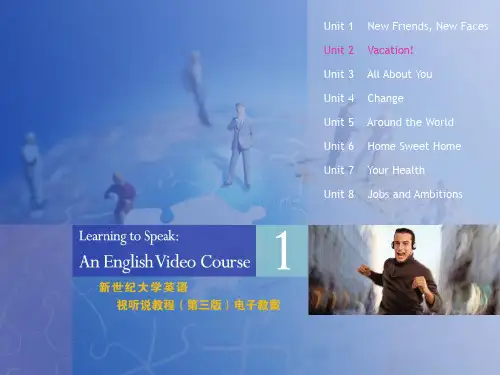
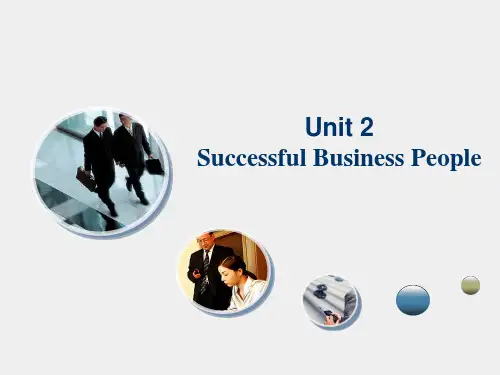
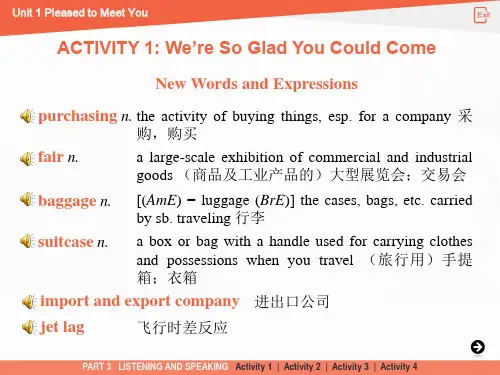
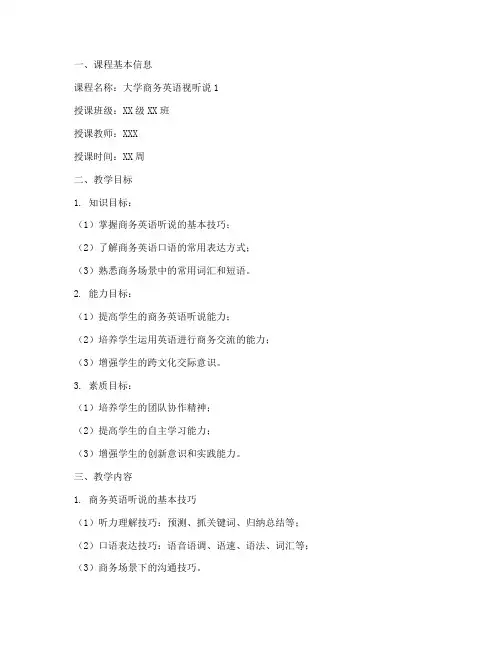
一、课程基本信息课程名称:大学商务英语视听说1授课班级:XX级XX班授课教师:XXX授课时间:XX周二、教学目标1. 知识目标:(1)掌握商务英语听说的基本技巧;(2)了解商务英语口语的常用表达方式;(3)熟悉商务场景中的常用词汇和短语。
2. 能力目标:(1)提高学生的商务英语听说能力;(2)培养学生运用英语进行商务交流的能力;(3)增强学生的跨文化交际意识。
3. 素质目标:(1)培养学生的团队协作精神;(2)提高学生的自主学习能力;(3)增强学生的创新意识和实践能力。
三、教学内容1. 商务英语听说的基本技巧(1)听力理解技巧:预测、抓关键词、归纳总结等;(2)口语表达技巧:语音语调、语速、语法、词汇等;(3)商务场景下的沟通技巧。
2. 商务英语口语常用表达方式(1)自我介绍;(2)商务场合的寒暄;(3)商务会议、谈判、电话沟通等场景下的常用表达。
3. 商务英语常用词汇和短语(1)商务场景中的常用词汇;(2)商务英语中的常用短语和句型。
四、教学方法1. 讲授法:教师通过讲解,帮助学生掌握商务英语听说的基本技巧和常用表达方式;2. 案例分析法:通过分析实际商务场景中的对话,让学生了解商务英语口语的表达方式;3. 角色扮演法:让学生分组进行角色扮演,提高学生的实际商务沟通能力;4. 小组讨论法:引导学生围绕特定话题进行讨论,培养学生的团队协作精神;5. 课后自主学习:布置课后作业,要求学生通过查阅资料、观看视频等方式,巩固所学知识。
五、教学进度安排第1周:商务英语听说的基本技巧第2周:商务英语口语常用表达方式第3周:商务英语常用词汇和短语第4周:商务场景下的沟通技巧第5周:角色扮演第6周:小组讨论第7周:课程总结与评估六、教学评价1. 课堂表现:包括学生的出勤、参与度、合作精神等;2. 课后作业:检查学生的课后学习效果;3. 角色扮演和小组讨论:评估学生的实际商务沟通能力;4. 期末考试:测试学生的商务英语听说能力。


《商务英语视听说》下册教案第一章:商务英语听说基础1.1 教学目标能够使用基本的商务英语词汇和句型进行日常交流。
能够理解和使用商务场景中的常见表达和礼貌用语。
1.2 教学内容商务英语的基本词汇和句型。
商务场景中的常见表达和礼貌用语。
1.3 教学方法通过听力练习和口语练习来提高学生的听说能力。
使用情景模拟和角色扮演来练习商务场景中的交流。
1.4 教学评估通过听力测试和口语测试来评估学生的学习效果。
第二章:商务电话沟通2.1 教学目标能够使用英语进行商务电话沟通,包括拨打电话和接听电话。
能够理解和使用商务电话沟通中的常见表达和技巧。
2.2 教学内容商务电话沟通的基本原则和技巧。
商务电话沟通中的常见表达和礼貌用语。
2.3 教学方法通过听力练习和口语练习来提高学生的电话沟通能力。
使用模拟电话交流情景来进行角色扮演练习。
2.4 教学评估通过模拟电话交流测试来评估学生的学习效果。
第三章:商务会议交流3.1 教学目标能够使用英语进行商务会议交流,包括会议准备和会议进行中的沟通。
能够理解和使用商务会议交流中的常见表达和技巧。
3.2 教学内容商务会议交流的基本流程和技巧。
商务会议交流中的常见表达和礼貌用语。
3.3 教学方法通过听力练习和口语练习来提高学生的会议交流能力。
使用模拟会议情景来进行角色扮演练习。
3.4 教学评估通过模拟会议交流测试来评估学生的学习效果。
第四章:商务谈判技巧4.1 教学目标能够使用英语进行商务谈判,包括谈判准备和谈判过程中的沟通。
能够理解和使用商务谈判中的常见表达和技巧。
4.2 教学内容商务谈判的基本原则和技巧。
商务谈判中的常见表达和礼貌用语。
4.3 教学方法通过听力练习和口语练习来提高学生的谈判能力。
使用模拟谈判情景来进行角色扮演练习。
4.4 教学评估通过模拟谈判测试来评估学生的学习效果。
第五章:商务演讲与报告5.1 教学目标能够使用英语进行商务演讲和报告,包括演讲准备和报告呈现。
能够理解和使用商务演讲和报告中的常见表达和技巧。
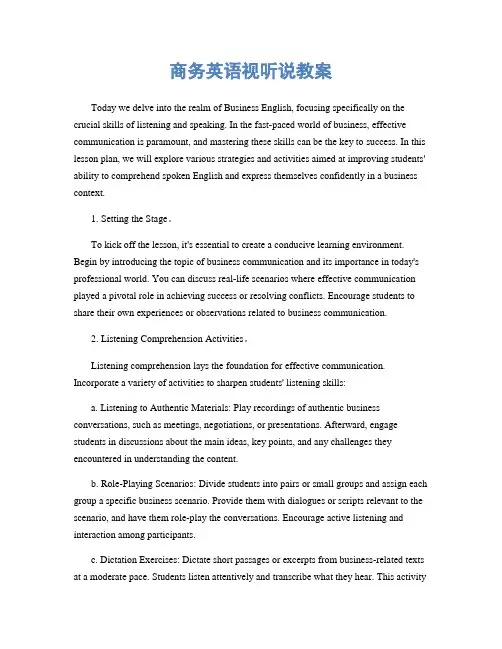
商务英语视听说教案Today we delve into the realm of Business English, focusing specifically on the crucial skills of listening and speaking. In the fast-paced world of business, effective communication is paramount, and mastering these skills can be the key to success. In this lesson plan, we will explore various strategies and activities aimed at improving students' ability to comprehend spoken English and express themselves confidently in a business context.1. Setting the Stage。
To kick off the lesson, it's essential to create a conducive learning environment. Begin by introducing the topic of business communication and its importance in today's professional world. You can discuss real-life scenarios where effective communication played a pivotal role in achieving success or resolving conflicts. Encourage students to share their own experiences or observations related to business communication.2. Listening Comprehension Activities。
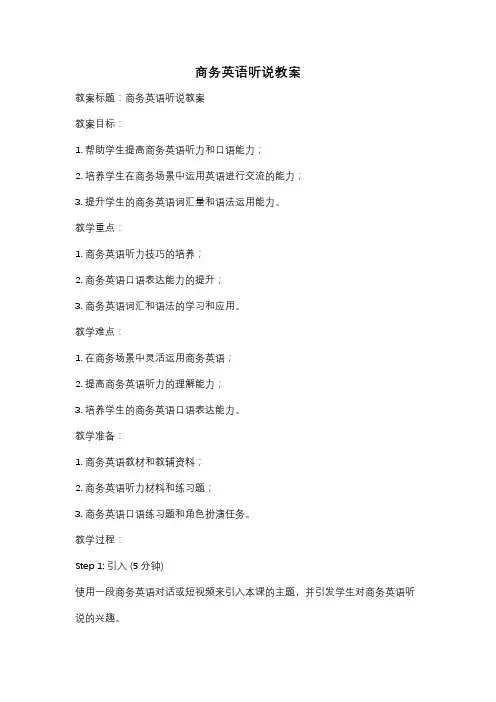
商务英语听说教案教案标题:商务英语听说教案教案目标:1. 帮助学生提高商务英语听力和口语能力;2. 培养学生在商务场景中运用英语进行交流的能力;3. 提升学生的商务英语词汇量和语法运用能力。
教学重点:1. 商务英语听力技巧的培养;2. 商务英语口语表达能力的提升;3. 商务英语词汇和语法的学习和应用。
教学难点:1. 在商务场景中灵活运用商务英语;2. 提高商务英语听力的理解能力;3. 培养学生的商务英语口语表达能力。
教学准备:1. 商务英语教材和教辅资料;2. 商务英语听力材料和练习题;3. 商务英语口语练习题和角色扮演任务。
教学过程:Step 1: 引入 (5分钟)使用一段商务英语对话或短视频来引入本课的主题,并引发学生对商务英语听说的兴趣。
Step 2: 商务英语听力训练 (15分钟)使用商务英语听力材料,让学生进行听力练习。
可以选择商务会议、电话沟通或商务洽谈等场景,让学生通过听力材料来提高他们的商务英语听力理解能力。
Step 3: 商务英语口语练习 (20分钟)将学生分成小组,给每个小组分配一个商务场景,例如商务洽谈、客户服务、商务演讲等。
要求学生在规定时间内准备并进行角色扮演,模拟真实商务场景中的英语交流。
Step 4: 商务英语词汇和语法学习 (15分钟)通过教材或教辅资料,教授与商务英语相关的词汇和语法知识。
可以选择一些常用的商务词汇和句型,让学生进行学习和应用。
Step 5: 拓展活动 (10分钟)提供一些商务英语听说的拓展活动,例如商务英语歌曲欣赏、商务英语电影片段观看等。
这些活动可以帮助学生巩固所学的商务英语知识,并提高他们的学习兴趣。
Step 6: 总结与反馈 (5分钟)对本节课的学习内容进行总结,并给予学生反馈。
可以针对学生在口语表达或听力理解方面的表现进行评价,并给予建议和指导。
教学延伸:1. 建议学生多参加商务英语角色扮演活动,提高他们在真实商务场景中的应对能力;2. 鼓励学生多进行商务英语听力训练,例如通过商务英语广播、商务英语播客等方式来提高他们的听力理解能力;3. 推荐学生阅读商务英语相关的文章和书籍,扩大他们的商务英语知识面。

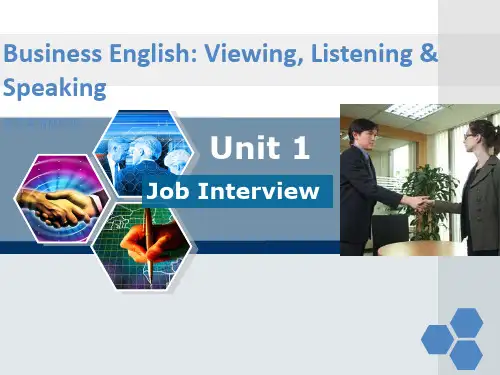
《商务英语视听说》receiving guests at the office教学设计一、教学目标1. 学生能够掌握基本的商务接待用语。
2. 学生能够在实际情境中运用所学知识进行商务接待。
3. 培养学生的跨文化交际意识和团队协作能力。
二、教学内容1. 商务接待的基本流程和礼仪。
2. 常用接待用语和表达方式。
3. 实际情境模拟:接待外国客户。
三、教学步骤1. 导入(5分钟)通过播放一段商务接待的视频,让学生了解商务接待的基本流程和礼仪。
提问学生关于视频中的商务接待的感受,引导学生进入本课主题。
2. 新课学习(20分钟)1)讲解商务接待的基本流程和礼仪,包括迎接、介绍、引导、送行等环节。
通过PPT展示相关图片和示例,让学生更加直观地了解所学内容。
2)学习常用接待用语和表达方式,包括如何表达欢迎、如何介绍公司、如何询问客户需求等。
通过角色扮演和小组讨论,让学生实际操作练习所学知识。
3. 实际情境模拟(25分钟)1)将学生分成若干小组,每组模拟接待外国客户的过程。
学生需根据所学知识设计接待方案,并在课堂上展示。
通过小组互评和教师点评,让学生更好地掌握所学内容。
2)针对模拟中出现的问题和不足之处,进行有针对性的讲解和纠正,让学生更加深入地了解商务接待的实际操作。
4. 总结与作业(5分钟)1)总结本节课所学内容,强调商务接待的重要性和实际应用价值。
引导学生思考如何在今后的学习和工作中运用所学知识。
2)布置作业:要求学生回家后复习本节课所学内容,并准备一个简短的商务接待模拟表演,下节课进行展示。
四、教学方法1.讲解与示范:教师对商务接待的基本流程和礼仪进行讲解,并通过示范让学生了解正确的操作方式。
2.角色扮演与小组讨论:通过角色扮演让学生实际操作练习所学知识,小组讨论可以让学生互相学习和交流。
3.实际情境模拟:模拟商务接待的实际情境,让学生亲身体验和实践所学知识。
五、教学资源1.PPT:展示商务接待的基本流程和礼仪、常用接待用语和表达方式等相关内容。
商务英语1听说任务2任务描述:本次任务要求学生通过听力和口语的练,针对商务英语1中的主要话题进行交流。
任务内容包括:商务会议、商务电话、商务演讲等。
任务步骤:1. 首先,通过听力练,提高对商务英语1中的关键词汇、短语和句子的理解和掌握。
可以通过课堂教学、教材配套的录音材料或在线商务英语资源进行听力训练。
2. 接下来,通过口语练,模拟商务场景,练对话和演讲技巧。
可以选择与同学进行角色扮演,或者通过录像自己演练,反复练并改进。
3. 进一步巩固知识和提高口语表达水平,可以参考相关商务英语研究资料,例如商务英语词汇书、商务英语口语教材等。
同时,可以通过与外教进行交流,获得更正和建议,提高口语流利度和准确性。
4. 最后,通过反复练和实践,逐渐锻炼听力和口语技能,达到能够熟练运用商务英语进行交流的水平。
任务要求:- 用英语进行听力和口语练,尽量避免使用中文。
- 重点关注商务英语1中的主要话题,包括会议、电话和演讲等。
- 提高听力和口语技能的同时,要注重提高专业商务用语和礼仪的运用。
任务评价标准:- 听力准确度:对商务英语1中的关键词汇、短语和句子的听力理解和掌握程度。
- 口语表达能力:在模拟商务场景中的对话和演讲中,语法准确度、流利度和词汇丰富度等。
参考资料:- 《商务英语1教材》- 在线商务英语研究资源(如BBC Learning English、Business English Pod等)- 商务英语研究资料(如商务英语词汇书、商务英语口语教材)任务时间安排:根据个人时间和进度安排听力训练和口语练,建议每周至少分配2-3小时。
任务确认:- 任务目标:通过听力和口语练,提高商务英语1的听说能力。
- 任务内容:商务会议、商务电话、商务演讲等。
- 任务要求:用英语进行练,注重专业商务用语和礼仪。
- 任务评价标准:听力准确度、口语表达能力。
- 参考资料:商务英语1教材、在线研究资源、商务英语研究资料。
- 任务时间安排:根据个人时间和进度安排每周2-3小时。